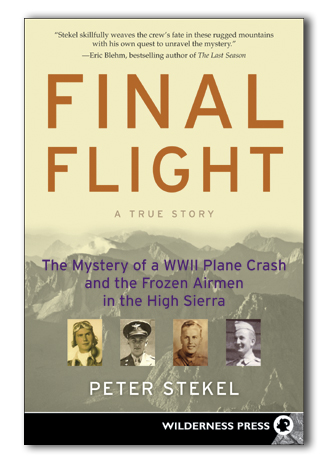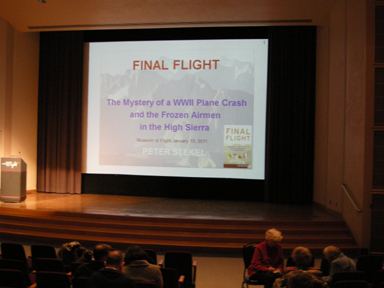|
|
FINAL FLIGHT a blog by Peter Stekel FINAL FLIGHT is the story of four aviators lost in Sequoia & Kings Canyon National Parks on November 18, 1942
Read more about FINAL FLIGHT here.
Order Final Flight from Your Local Bookstore, Amazon or Powell's World of Books in Oregon |
|||||
|
January 2011 On January 15 I spoke at the Museum of Flight in Seattle. Program details HERE. There were about 70 people in attendance and 16 books were sold. See the Museum of Flight calendar announcement for my appearance HERE.
|
||||||
|
US Military Deaths in WWII For those of you interested in the development of national cemeteries, I suggest you read the story of Arlington National Cemetery, On Hallowed Ground, by Robert Poole. According to official Department of Defense figures the number of US soldiers serving in WWII was 16,112,566 [16.1 million]. Of these, 671,846 were wounded. There were 405,399 deaths. Of these, 291,557 were killed in action [KIA]. The remainder, 113,842 [28%], of deaths were non-combat deaths. I don't know where the 81,000 MIA soldiers from WWII fit into these figures. The number/percentage of non-combat deaths were startling numbers to me when I first learned them. But when I thought about past conflicts, especially the War Between the States, it all came into focus. As Robert M. Poole writes in On Hallowed Ground, "If a soldier survived battle, and the painful journey from the front, and the brusque attentions of army doctors, he remained a prime target for gangrene, pneumonia, diarrhea, typhoid, smallpox, measles, malaria, and the other fatal diseases haunting army camps and hospitals - indeed, sickness and infection would kill many more Civil War soldiers than bullets." The main causes of death during the Great War included the same diseases [and others, I assume] as in the Civil War but infection of wounds as well as infection from what we would consider slight injuries [blisters, cuts, bruises] claimed more victims than disease. In fact, I found in a 1919 report from, "The War with Germany, a Statistical Summary" by Colonel Leonard P. Ayers (Chief of the Statistical Branch of the General Staff) that, "Of every 100 American soldiers and sailors who took part in the war with Germany, 2 were killed or died of disease during the period of hostilities. "In the Northern Army during the Civil War the number was about 10. Among the other great nations in this war, between 20 and 25 in each 100 called to the colors were killed or died. To carry the comparison still further, American losses in this war were relatively one-fifth as large as during the Civil War and less than one-tenth as large as in the ranks of the enemy or among the nations associated with us. "The war was undoubtedly the bloodiest which has ever been fought. One possible competitor might be the Crimean War in which the casualty rate per 100 men was equally heavy. The British forces in the Crimean War lost 22 of every 100 men, the French 31, the Turkish 27, and the Russian 43. More than four fifths of the losses were, however, deaths from disease, while in the recent war with Germany disease deaths were inconsiderable as compared with battle deaths. The forces engaged in the Crimean war were, moreover, much smaller." Wikipedia says the American Expeditionary Forces sustained about 320,000 casualties during the Great War. Of these, 53,402 were battle deaths and 63,114 non-combat deaths. There were 204,000 wounded. The high AEF casualty count was sustained at a time when French casualties for just one year, 1918, were 330,000. Somewhere between 20-40 million died in 1918 during the flu pandemic. These numbers helped put our WWII combat and non-combat deaths in perspective for me. According to Anthony J. Mireles in his book, Fatal Army Air Forces Aviation Accidents in the United States, 1941-1945, "During World War II, the air over the continental United States was a virtual third front. The little-known statistics are alarming: the Army Air Forces lost more than 4,500 aircraft in combat against Japanese army and naval air forces in the war. "During the same time, the AAF lost more than 7,100 aircraft in the United States to accidents in training and transportation. "Such accidents claimed the lives of more than 15,530 pilots, crewmembers and ground personnel."
|
||||||
|
|
||||||
|
WISDOM FROM MILITARY AND FLIGHT TRAINING MANUALS If the enemy is in range, so are you - Infantry Journal It is generally inadvisable to eject directly over the area you just bombed. - US Air Force Manual Whoever said the pen is mightier than the sword, obviously never encountered automatic weapons. - General MacArthur You, you, and you ... Panic. The rest of you, come with me. - Infantry Sgt. Tracers work both ways. - Army Ordnance Manual Five second fuses last about three seconds. - Infantry Journal The three most useless things in aviation are: Fuel in the bowser; Runway behind you; and Air above you. - Basic Flight Training Manual Any ship can be a minesweeper. Once. - Naval Ops Manual Never tell the Platoon Sergeant you have nothing to do. - Unknown Infantry Recruit If you see a bomb technician running, try to keep up with him. - Infantry Journal Yea, Though I Fly Through the Valley of the Shadow of Death, I Shall Fear No Evil. For I am at 50,000 Feet and Climbing. - Sign over SR71 Wing Ops You’ve never been lost until you’ve been lost at Mach 3. - Paul F. Crickmore (SR71 test pilot) The only time you have too much fuel is when you're on fire. -Unknown Author If the wings are traveling faster than the fuselage it has to be a helicopter - and therefore, unsafe. - Fixed Wing Pilot When one engine fails on a twin-engine airplane, you always have enough power left to get you to the scene of the crash. -Multi-Engine Training Manual Without ammunition, the Air Force is just an expensive flying club. -Unknown Author If you hear me yell, "Eject, Eject, Eject!" the last two will be echoes. If you stop to ask "Why?" you’ll be talking to yourself, because by then you’ll be the pilot. -Pre-flight Briefing from a Canadian F104 Pilot What is the similarity between air traffic controllers and pilots? If a pilot screws up, the pilot dies. But If ATC screws up, the pilot dies. -Sign over Control Tower Door Never trade luck for skill. -Author Unknown The three most famous last words in aviation are: "Did you feel that?" "What’s that noise?" and, "Oh Shit!" Airspeed, altitude and brains. Two are always needed to successfully complete the flight. -Basic Flight Training Manual Flying the airplane is more important than radioing your plight to a person on the ground incapable of understanding or doing anything about it. - Emergency Checklist The Piper Cub is the safest airplane in the world; it can just barely kill you. - Attributed to Max Stanley (Northrop test pilot) There is no reason to fly through a thunderstorm in peacetime. -Sign over Squadron Ops Desk at Davis-Montham AFB, AZ You know that your landing gear is up and locked when it takes full power to taxi to the terminal. - Lead-in Fighter Training Manual As the test pilot climbs out of the experimental aircraft, having torn off the wings and tail in the crash landing, the crash truck arrives. The rescuer sees the bloodied pilot and asks, "What happened?" The pilots reply, "I don't know, I just got here myself." |
||||||
|
||||||
|
write to: peter[at]FinalFlightTheBook.com |
||||||
|
|
||||||
|
copyright 2010 Peter Stekel all rights reserved |
||||||


